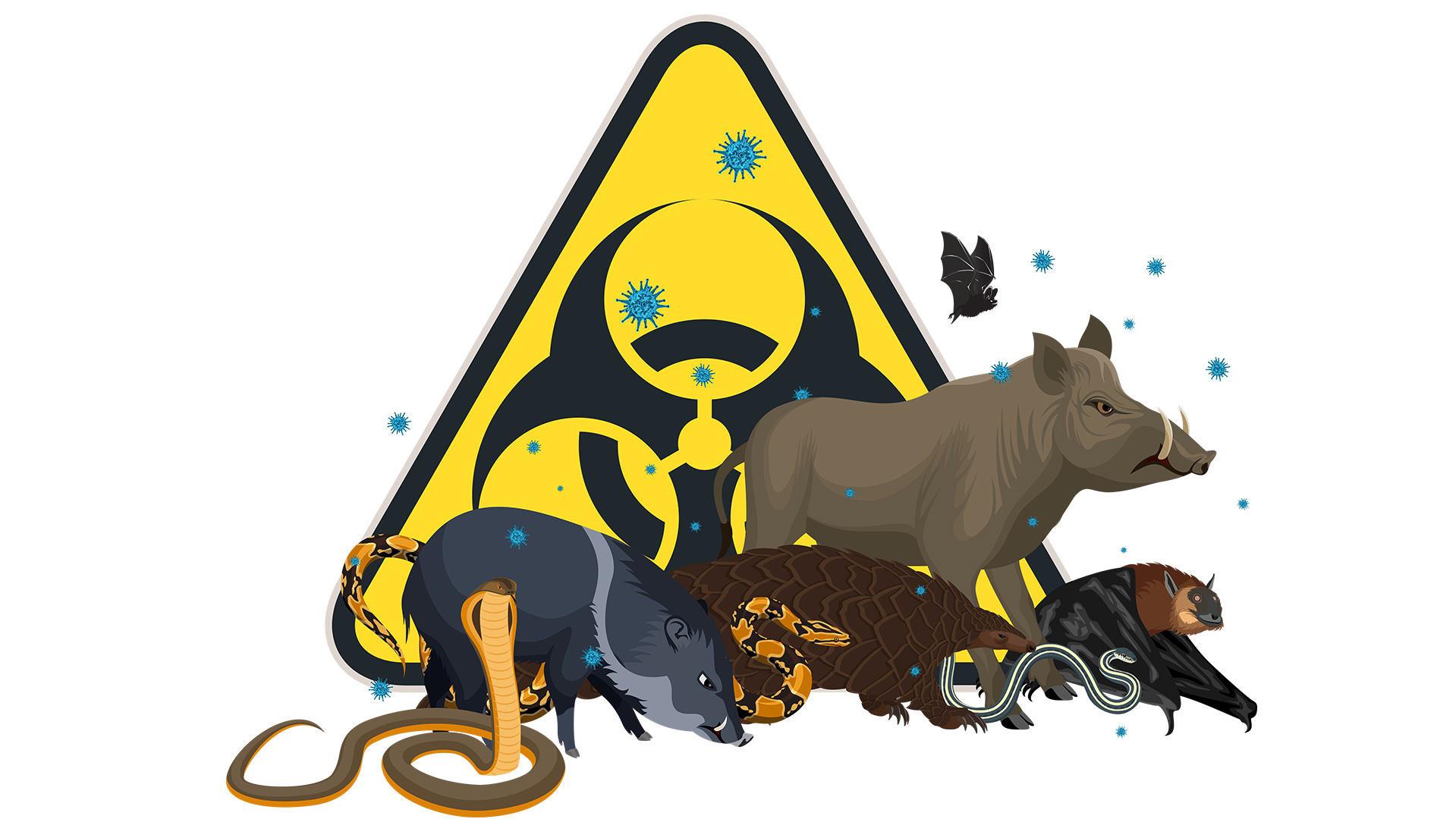
Maybe I haven’t been paying attention over recent decades and I’m only just now catching on, but this year’s Covid-19 crisis has thrown light on a surprisingly consistent pattern when it comes to the sources of pandemics.
Consider these seven deadly viruses that have wreaked havoc (Note: the information in the following list is largely drawn from the World Health Organization):
#1. Covid-19 Most likely originated from human contact with a bat or pangolin (scaly anteater) at a wet market in Wuhan, China, where live or freshly slaughtered animals are sold for meat and traditional medicine. Death toll: 400,000 (approximately, as this pandemic is not over yet).
#2. MERS (also a coronavirus strain) Most likely passed into the human population through contact with camels in the Middle East that, in turn, may have received the virus from bats. Death toll: 871 since 2012.
#3. SARS (also a coronavirus strain) Most likely passed into the human population through contact with a cat/mongoose-like civet in a Yunnan province, China, wet market, which had, in turn, received the virus from a horsehoe bat. Death toll: 774 (2002–2003 outbreak).
#4. H1N1 (swine flu) One of a number of influenza strains that pass from pigs to humans, possibly including the case of the 1918 Spanish flu, which killed somewhere between 17 and 50 million people. Death toll: 150,000–575,000 (2009 outbreak).
#5. H5N1 (bird flu) Another influenza strain that is believed to have originated with wild waterfowl, but crossed over to humans at poultry farms. Death toll: 359 (1997–2012 outbreak).
#6. Ebola Most likely passed into the human population through hunting and eating a variety of wild animals, including fruit bats, which are believed to be the original source. Death toll: 11,323 (2013–2016 outbreak).
#7. HIV Most likely passed into the human population via “bush meats” in West-Central Africa, in particular monkeys and chimpanzees. HIV/AIDS then spread around the world, largely through unprotected casual sex. Death toll: 32 million (1981–2018).

What do all these viral pandemics have in common? They are each described as a zoonosis; that is, a pathogen that has jumped from animals to humans. But I would go one step further to suggest that we humans have, to a large extent, brought these pandemics on ourselves.
Consider the human behaviours that have led to these pandemics: the hunting, slaughter and sale of all kinds of exotic wild animals for meat and traditional medicine; the increasing use of industrial farming methods where large numbers of animals are crowded together; unprotected casual sex and the breaking of marriage vows. Of course, there are factors that have pushed people to choose these behaviours: urbanisation, perhaps—deforestation, dispossession, poverty, desperation, as well as plain greed, lust and ignorance. But the reality remains: we humans have interfered with the natural balance in ways it was never meant to be interfered with.
What might surprise you is the existence of ancient principles of health and hygiene that, if followed, would largely erase the risk of similar future pandemics. I’m referring to the ancient Hebrew Torah, in particular the books of Leviticus and Deuteronomy. These books, which list all kinds of laws and regulations for many areas of life, are often dismissed as boring and irrelevant . . . until you have a query about a specific topic, at which point it’s easy to become fascinated! I’m not suggesting that each of these regulations are directly relevant to our situation today, but the principles and practices they enunciate are often surprisingly useful.
Both Leviticus 11 and Deuteronomy 14 list and describe animals, birds, fish and insects that are “clean” and therefore suitable for human consumption. They also explain which animals are “unclean”. These food laws are at the historic foundation of present-day Jewish kosher and Islamic halal requirements. A cursory scan might leave the reader wondering at the random strangeness of the ancient mind, but a more careful reading reveals a surprising ecological rationality: the animals described as unclean are more likely to be carnivores, scavengers or filter feeders, species that, in contrast to herbivores, are at risk of having concentrated environmental toxins in their bodies.
And, for our purposes here, in considering zoonotic viruses, bats, pigs, camels and a number of waterfowl species are specifically listed as unclean—pangolins, civets, monkeys and apes are not specifically named, but also clearly fall outside the “clean animal” category, which is defined as “any animal that has a divided hoof and chews the cud” (Leviticus 11:3).
The Torah extends the category of “unclean” to an animal found dead, be it otherwise unclean or clean (a clean animal found dead rather than slaughtered would probably have died of a sickness). A person who touched a dead animal would be required to self-quarantine for the rest of the day and wash their clothes before returning to contact with the community. Any object that the dead animal had touched would have to be either washed or destroyed; in particular, objects used to store food or water, or to prepare meals.
How could this gaggle of escaped slaves, wandering around the Sinai desert more than 3000 years before the microscope and modern germ theory, have possibly been able to put together such a cogent and rigorous hygiene and decontamination regime? For me, this is evidence that the Torah, if not the Bible as a whole, is more than a human document—there’s divine wisdom there.
If humanity as a whole had adopted these ancient guidelines—rejecting unclean animals for food, avoiding contact with animals dead from sickness and decontaminating in case of accidental contact—it’s doubtful whether we would be now dealing with what looks like an increasing number of pandemics. It makes me wonder if there aren’t other God-given principles in the Bible worth considering as I decide how I’m going to live my life.
What exactly does Leviticus 11 say about clean and unclean meats?
“Of all the animals that live on land, these are the ones you may eat: you may eat any animal that has a divided hoof and that chews the cud.
“There are some that only chew the cud or only have a divided hoof, but you must not eat them. The camel, though it chews the cud, does not have a divided hoof; it is ceremonially unclean for you. The hyrax, though it chews the cud, does not have a divided hoof; it is unclean for you. The rabbit, though it chews the cud, does not have a divided hoof; it is unclean for you. And the pig, though it has a divided hoof, does not chew the cud; it is unclean for you. You must not eat their meat or touch their carcasses; they are unclean for you.
“Of all the creatures living in the water of the seas and the streams you may eat any that have fins and scales. But all creatures in the seas or streams that do not have fins and scales—whether among all the swarming things or among all the other living creatures in the water—you are to regard as unclean. . . .
“These are the birds you are to regard as unclean and not eat because they are unclean: the eagle, the vulture, the black vulture, the red kite, any kind of black kite, any kind of raven, the horned owl, the screech owl, the gull, any kind of hawk, the little owl, the cormorant, the great owl, the white owl, the desert owl, the osprey, the stork, any kind of heron, the hoopoe and the bat.
“All flying insects that walk on all fours are to be regarded as unclean by you. There are, however, some flying insects that walk on all fours that you may eat: those that have jointed legs for hopping on the ground. Of these you may eat any kind of locust, cricket, cicada or grasshopper. But all other flying insects that have four legs you are to regard as unclean. . . .
“Of the animals that move along the ground, these are unclean for you: the weasel, the rat, any kind of great lizard, the gecko, the monitor lizard, the wall lizard, the skink and the chameleon. . . .”
Note: The precise identification of some species listed is uncertain, due to the difficulty in translating from ancient Hebrew.
Kent Kingston is editor of Signs of the Times and lives in Lake Macquarie, NSW.









